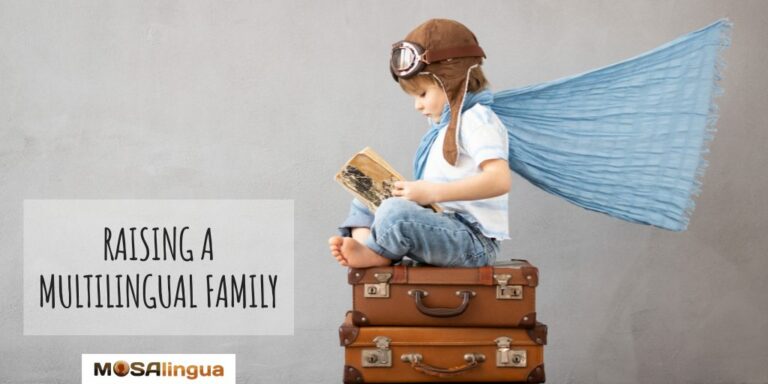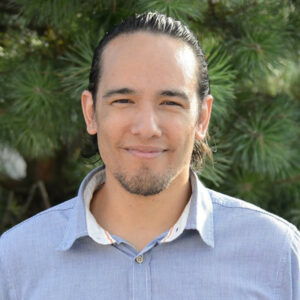If you’ve found your way to this blog, it’s because, like us, you love languages. And if you’re a parent, you probably want to pass on some of that passion to your children. Perhaps you’ve even dreamed of having a bilingual family. It can seem like a lofty goal, so I spoke to polyglot Samuel W., a longtime member of the MosaLingua team and father of two, to get his perspective and advice. I wanted to know: did he try to teach his kids a foreign language? Spoiler: yes, and they ended up much more than that! Wondering how (and why) he did it? Read on!

Meet Samuel W. and His Bilingual Family
At MosaLingua, we can’t stress it enough: linguistic diversity adds immeasurable richness to the world and our lives! In human terms, it opens us up to others and encourages us to be more accepting and curious. Intellectually, it increases our cognitive capacity. Professionally, it offers unique advantages and opportunities.

I wanted to find out more about Samuel W., a member of the team and father to two young boys. Samuel speaks French, English, Spanish, Italian, and Romanian. How has he tried to instill his love for languages in his children, and how have they responded? I was also interested in the challenges he and his wife have faced.
Samuel, can you introduce yourself and tell us about how you became interested in languages?
I grew up in France, but my family is English, so I was brought up speaking both languages.
My father always told us that outside the house it was France, but inside it was England. In other words, we had to speak English at home. It may sound a bit strict, but this rule was absolutely beneficial for me and my siblings to learn English.
When I left France at 14 to go to England, I lost a lot of my French, especially my writing.
Then, after my older sister married a Spaniard, my mother seized the opportunity to migrate to the sunshine and take us to live near them. I was 19 at the time. That’s how I learned Spanish, in complete immersion on the Iberian peninsula.
Later, I also decided to learn a little Chinese.
Three years later, I moved back to England, where I met my wife who is Romanian. I’m sure you can see where I’m going with this! We’ve been living in Romania for 12 years now and have two boys, aged 7 and 9.
Then I imagine that raising a bilingual family was an obvious choice for you.
Having grown up in a bilingual home myself, it was only natural to teach them at least one, if not several, languages. I also wanted them to be able to speak to all the members of their family, in the broadest sense.
Many Romanians move abroad and don’t teach their children their own language. I think that’s a pity because it means that grandparents can’t communicate with their grandchildren, whom they only see once a year, if that.
Start learning a new language today

Good news: we can help!
More good news: you can get started for free! Start your free trial now and for the next 15 days, take advantage of the most effective language learning method on the market!
Vocabulary flashcards, videos with subtitles, audiobooks, articles adapted to your level – with MosaLingua Premium (Web & Mobile), you’ll have access to all this and more. Get started right now. It’s free—and risk-free—to try!
What strategies did you use to introduce several languages to your kids at once?
Since my wife speaks English, we decided that she would speak to them in English, I would speak to them in French, and they would learn Romanian from family and friends. Later, they would also use Romanian at school, although in the end, we opted to homeschool them.
I personally felt totally confident in this choice. It made sense. I myself had been brought up in a similar linguistic environment, with one small difference: my sons have one extra language.
My wife, on the other hand, had doubts. Some of them were probably fueled by the people around her—doctors were among those who expressed concern. Not everyone agreed with this particular parenting decision.
When did your children first show signs of being bilingual?
As time went on and our first child started talking, my wife realized that there was nothing to worry about. She was amazed that he could tell the difference between the languages, and even translate!
Something really interesting happened when our youngest son was about 18 months old. He was hungry and started asking for something to eat. Thinking he was talking to me, he said “manger” in French. He then realized it wasn’t me, but his mother standing next to him, so he corrected himself and said, “eat.” That interaction reassured us that we had made the right choice.
Did you use any specific strategies to help support your bilingual family?
My children already knew I spoke Spanish since we went on vacation in Spain a lot. They had also heard me speaking Spanish on the phone to friends and family.
They are the ones who asked me to teach them Spanish. Truthfully, I didn’t know if I could do it. I wasn’t yet familiar with the ML@H (Minority Language at Home) method or the OPOL (One Parent-One Language) method, both of which are explained in detail in this article.
So you didn’t know that there were established methods for fostering a bilingual home?
Before I even knew that these methods had names, I had set them up and applied them on a daily basis with my family.
When I realized that my sons were curious about Spanish, I decided to introduce them to the language through games. This was back in the day of the UNO craze. That game made it easy to teach numbers and colors in Spanish during playtime. And the kids loved it!
So much so that they kept asking for more. I set up a little rule. When we opened the box, we spoke Spanish. And when we closed the box, we reverted to French. If you’ve read the I mentioned previously, you’ll know that this is what they call the Time and Place method.
We soon applied this method to all games. Then to go shopping. Eventually, we started speaking Spanish every time we left the house!
At one point, I got worried that it would become too much and they’d start mixing languages. Because even with my father’s strict rule in place, as a child I tended to make mistakes like: “He’s embetting me” (from the French verb “embêter”).
So I decided to limit our Spanish to Saturdays. But they wanted to speak more, so we split the week in two. From Monday to Wednesday, we’d speak in Spanish and the remaining four days in French.
It seems like you’ve also passed on your affinity for learning new languages.
Totally! In fact, this system suited them for a while. Until they realized that I was learning Italian with MosaLingua. Long story short, now we devote Mondays and Tuesdays to Spanish, Wednesdays and Thursdays to Italian, and the rest to French.
At a certain point, we noticed that our children didn’t want to speak to us in Romanian in social situations. So we decided to start speaking Romanian during bath time and make it part of the routine. This is known as the Mixed Language Policy (MLP).
Our family actually applied all four language methods before we even knew their names!
So many languages in one household—it’s impressive!
If you came to visit us for a week, you’d hear us speak 5 languages.
They’ve now started learning German with MosaLingua, which proves that they love languages.
They’ve also asked me to teach them Chinese. Unfortunately, I can’t do that because my level isn’t quite good enough, and there just aren’t enough days in the week!
Next Steps 👣 Do You, Too, Dream of a Bilingual Family?
Did this article inspire YOU to introduce your family to a new language or aspire to a bilingual household?
If you’re interested in learning more about bilingualism, multilingualism, and fostering a bilingual household, check out the research that has been carried out by François Grosjean, a Swiss researcher and expert on the topic.
You might also like these other fascinating posts:
- Expert strategies, our personal experience, and great tips on how to raise a bilingual child
- Why – and How – to Teach Your Kids English [VIDEO]
- The incredible benefits of being bilingual
- What’s the best age to learn a foreign language?



![5 Tips for Traveling Abroad [VIDEO]](https://www.mosalingua.com/en/files/2018/03/19-300x169.jpg)
Comments